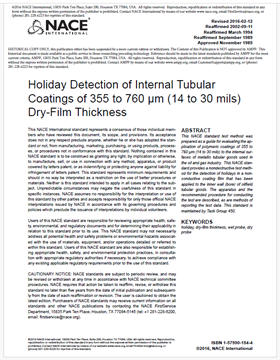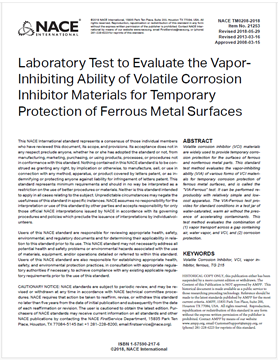Search
Products tagged with 'Downloadable'
View as
Sort by
Display
per page
NACE TM0186-2016, Holiday Detection of Internal Tubular Coatings of 355 to 760 μm (14 to 30 mils) Dry-Film Thickness
Product Number:
21218-SG
Publication Date:
2016
$179.00
NACE TM0190-2017, Impressed Current Laboratory Testing of Aluminum and Zinc Alloy Anodes
Product Number:
21221-SG
Publication Date:
2017
$179.00
NACE TM0197-2019, Laboratory Screening Test to Determine the Ability of Scale Inhibitors to Prevent the Precipitation of Barium Sulfate or Strontium Sulfate, or Both, from Solution (for Oil and Gas Production Systems)
Product Number:
21228-2019
Publication Date:
2019
$179.00
NACE TM0208-2018 "Laboratory Test to Evaluate the Vapor-Inhibiting Ability of Volatile Corrosion Inhibitor Materials for Temporary Protection of Ferrous Metal Surfaces"
Product Number:
21253-SG
Publication Date:
2018
$179.00
NACE TM0215-2015 “Test Method for Measurement of Gouge Resistance of Coating Systems”
Product Number:
21270-SG
Publication Date:
2015
$179.00
NACE TM0294-2016-SG, “Testing of Embeddable Impressed Current Anodes for Use in Cathodic Protection of Atmospherically Exposed Steel-Reinforced Concrete”
Product Number:
21225-SG
ISBN:
1-57590-133-1
Publication Date:
2016
$109.00
NACE TM0384-2016, Detection of Internal Tubular Coatings of Less Than 250 μm (10 mils) Dry-Film Thickness
Product Number:
21216-SG
Publication Date:
2016
$179.00
NACE TM0497-2022, Measurement Techniques Related to Criteria for Cathodic Protection on Underground or Submerged Metallic Piping Systems
Product Number:
NACE TM0497-2022
Publication Date:
2022
$109.00
NACE TM21423-2017 “Determination of Substrate and Surface Temperature Limits for Insulative Coatings used for Personnel Protection”
Product Number:
21423-SG
Publication Date:
2017
$179.00
NACE WJ-1/SSPC-SP WJ-1-2012 (Editorial Corrections 1/5/2017), Waterjet Cleaning of Metals—Clean to Bare Substrate (WJ-1)
Product Number:
21158-SG
$179.00
NACE WJ-1/SSPC-SP WJ-1-2012-SG (Chinese), “Waterjet Cleaning of Metals—Clean to Bare Substrate (WJ-1)” Chinese Translation
Product Number:
21191-SG
ISBN:
1-57590-248-6
$179.00
NACE WJ-2/SSPC-SP WJ-2-2012 (Editorial Corrections 1/5/2017), Waterjet Cleaning of Metals—Very Thorough Cleaning (WJ-2)
Product Number:
21155-SG
$179.00












